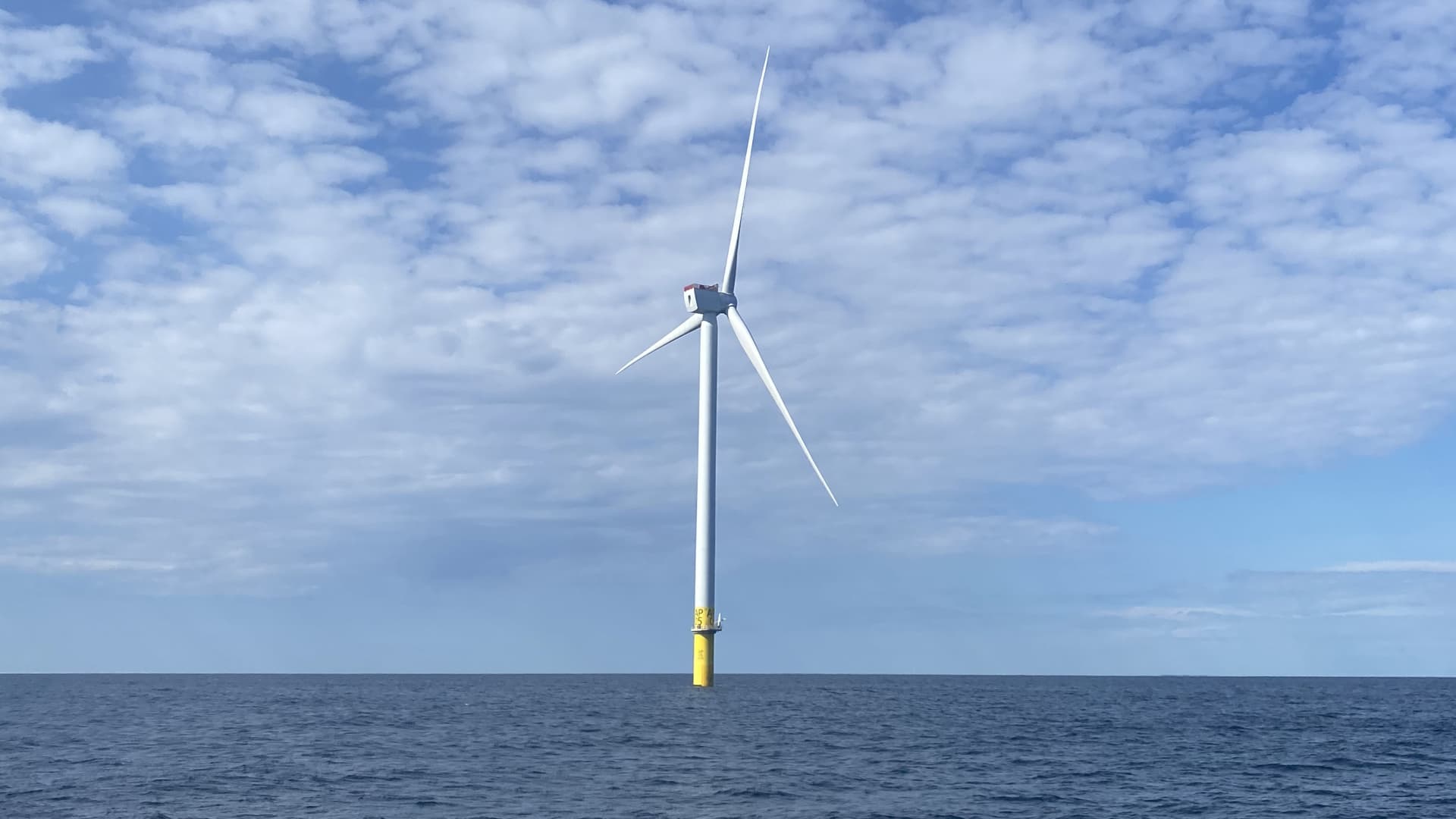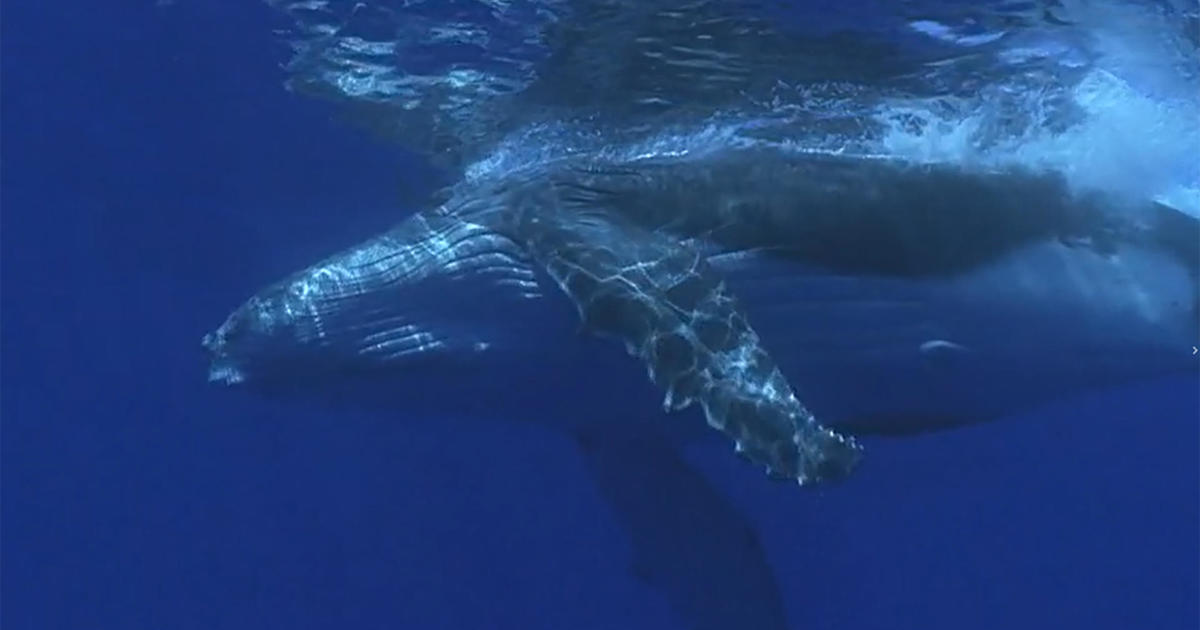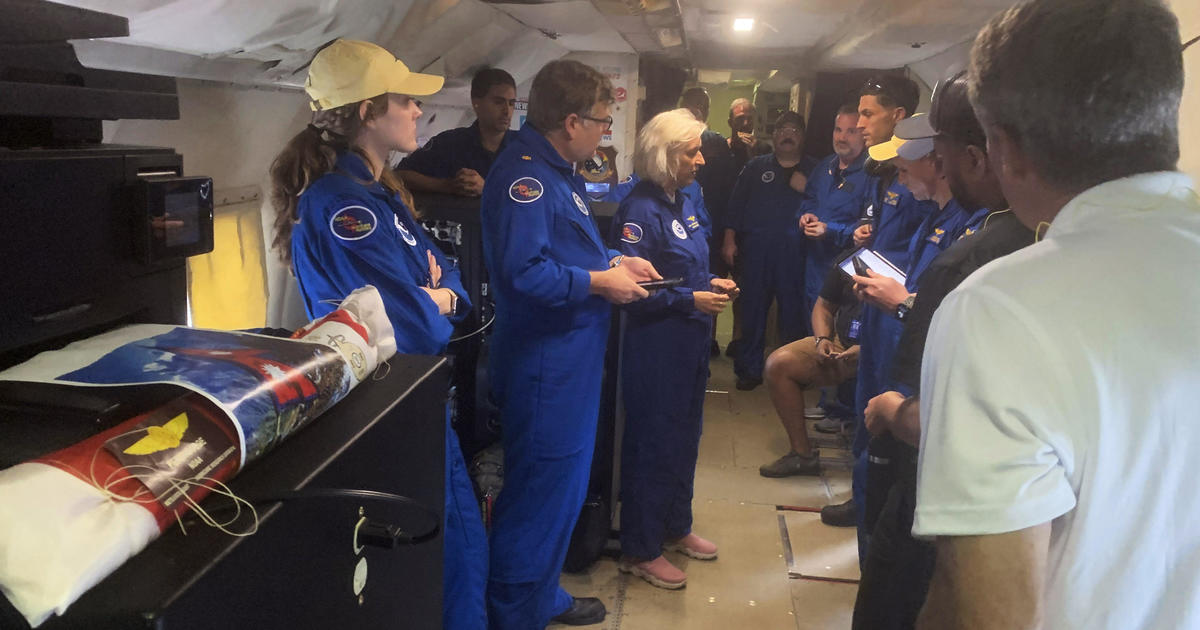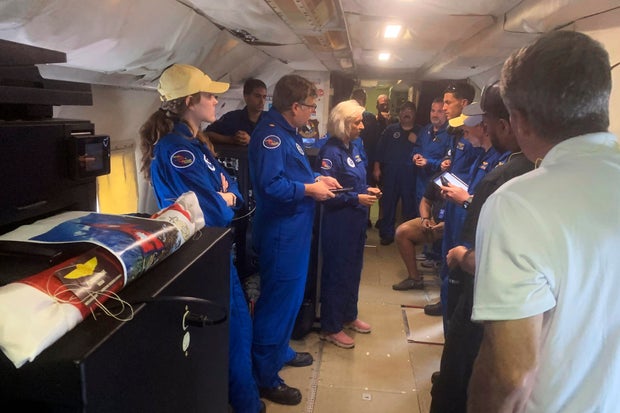Science & Environment
The first U.S. commercial-scale offshore wind project

GREENPORT, N.Y. – Roughly 35 miles off the east coast of Montauk, New York, 12 turbines gently spin in the wind at Orsted’s newly developed South Fork Wind farm. The project, which connected to the grid earlier this year, is the first commercial-scale offshore wind farm in the U.S., providing enough power for 70,000 homes annually.
It’s a needed bright spot for the U.S. offshore wind industry, which has faced a number of challenges getting off the ground. Rising interest rates and supply chain snags have changed project economics, forcing some developers to return to the market in search of higher contracted prices. Other projects have been canceled entirely.
Soren Lassen, head of offshore wind research at Wood Mackenzie, said the U.S. offshore wind industry is going through a needed readjustment, and that while the long-term outlook remains intact, progress has been pushed out. South Fork Wind offers tangible evidence that wind projects can work.
A long-term investment
Traveling by way of a high-speed ferry from Greenport, New York, it takes about two hours to get to South Fork Wind. It’s hard to get a sense of just how large these turbines are until you’re right under one: they tower 460 feet above the water, with blades that are each longer than a football field. And that’s just what the eye can see. Underwater, each tower sits atop a custom foundation drilled into the seabed. Apart from the gentle “swoosh” of the blades – only audible when right next to the turbine – the wind farm is otherwise quiet in the middle of the ocean.
South Fork Wind’s substation, which is connected to the power grid in East Hampton via a subsea and then underground cable.
Pippa Stevens | CNBC
Each turbine is connected to an offshore substation – the first of its kind built in the U.S. – which is connected to the local power grid in East Hampton, New York, via a 65-mile subsea and underground cable.
South Fork Wind was not without opposition. The waters off the Long Island coast have long been a place for recreational and commercial fisherman alike, some of whom opposed the project. Residents in Wainscott – the summer community where the cable comes ashore – also fought it. This led to Orsted adding extra space between each turbine so that the area remains open both to transit by pleasure and fishing boats, and the company buried the onshore cable beneath the beach and local roads.
Denmark-based Orsted is not new to the area. The company developed the five-turbine Block Island Wind Farm, which is northwest of South Fork Wind, in 2016. And northeast of South Fork Wind sits Revolution Wind – a 65-turbine project that Orsted broke ground on in 2023. In July, Orsted began construction on Sunrise Wind, which is also in federal waters off the New York coast.
Offshore wind projects are long-term investments, with work starting years before a single foundation is even drilled into the seabed. Securing the necessary permits is a lengthy process.
The Bureau of Ocean Energy Management first awarded the leases for South Fork Wind in 2013, which where acquired by Deepwater Wind. Orsted acquired the company in 2018 and partnered with Eversource Energy to start building the project. Onshore construction began in February 2022, with offshore construction following in 2023. In September, Skyborn Renewables, a Global Infrastructure Partners portfolio company, acquired Eversource’s 50% stake in both South Fork Wind and Revolution Wind.
South Fork Wind, which is 35 miles East of Montauk, New York.
Pippa Stevens | CNBC
Offshore wind developers typically use power purchase agreements, which are signed ahead of construction. Put simply, it’s a long-term agreement between the owner and a third party who agrees to pay a specific price for the power – oftentimes for 20 years or more. At South Fork Wind, the power is being sold to Long Island Power Authority.
While this model provides long-term certainty, it can also be a huge obstacle if project costs balloon. Orsted is developing Revolution Wind and Sunrise Wind, but last year it walked away from Ocean Wind 1 and 2, which were slated to be built off the coast of Atlantic City, New Jersey.
“Macroeconomic factors have changed dramatically over a short period of time, with high inflation, rising interest rates, and supply chain bottlenecks impacting our long-term capital investments,” David Hardy, CEO Americas at Ørsted, said in October 2023. “As a result, we have no choice but to cease development of Ocean Wind 1 and Ocean Wind 2.”
In May, Orsted agreed to pay New Jersey a $125 million settlement.
The financial problems are not unique to Orsted. Equinor and BP ended a joint venture to develop a project in waters off the coast of New York in January. Equinor took sole ownership of the project and re-entered the market in search of better prices – securing a deal for Empire Wind 1, but not for Empire Wind 2, which remains on pause.
High rates, supply chain struggles
The two main obstacles around building offshore wind farms are interest rates and the supply chain. Offshore wind is capital intensive: it takes a lot of money to build one of these projects in the middle of the sea, and as interest rates rose companies’ cost of capital surged. At the same time, raw material and labor costs accelerated out of the pandemic. It’s hard to begin construction without a PPA locked in, but if costs rise significantly above initial estimates, the PPA might not be high enough for the project to be feasible.
Each turbine at South Fork Wind rises 460 feet above the water.
Pippa Stevens | CNBC
Much of the supply chain is also highly specialized. There are only a few vessels in the world, for example, that can lay the underwater cables. Turbine installation vessels are also industry-specific. The offshore wind industry is not new globally, but it is in the U.S., meaning just a few years ago a domestic supply chain was virtually nonexistent.
But some of those supply chain constraints are beginning to ease as more and more projects get off the ground. Dominion Energy is building the first Jones Act-compliant turbine installation ship in Brownsville, Texas, which will be used to transport supplies to its Coastal Virginia Offshore Wind project. Once the project is completed, the ship will be contracted out to other companies.
‘Not disappearing’
Offshore wind port hubs are also popping up, including the South Brooklyn Marine Terminal, the Port of Virginia and Connecticut’s Port of New London. Orsted’s domestic supply chain now spans more than 40 states, and work for South Fork Wind took place in New York, South Carolina, Texas, Rhode Island and Connecticut, among other states.
The U.S. Department of the Interior recently approved its tenth offshore wind project – this one in Maryland – in what it called a “major milestone.” But the Biden administration’s goal of 30 gigawatts of offshore wind power by the end of this decade remains far off.
South Fork Wind’s offshore substation is the first-of-its-kind built in the U.S.
Pippa Stevens | CNBC
Vineyard Wind, off the coast of Martha’s Vineyard and Nantucket, Massachusetts, is the only other commercial-scale offshore wind project currently powering homes. Developer Avangrid had to pause construction over the summer after a blade broke off and fell into the ocean, with parts ultimately washing ashore on Nantucket beaches. GE Vernova, which made the blade, called it a “manufacturing deviation” related to “insufficient bonding” in the blade.
Two other projects – Block Island Wind Farm and Dominion’s two-turbine Coastal Virginia Offshore Wind Pilot Project – are operational, although they are much smaller, powering 17,000 and 3,000 homes, respectively.
The U.S. does have 58 gigawatts of capacity under development, according to American Clean Power, but some of those projects won’t come online for years, and there is no guarantee all of them will be built. The industry group estimates that $65 billion will be invested in offshore wind by 2030, supporting 56,000 jobs – up from 1,000 today.
“There are cycles in everything, and now we’re going through a negative cycle,” said Wood Mackenzie’s Lassen, in an interview. “That means that what is now driving the adjustments to price are, instead of success, failures.”
But Lassen is encouraged projects are pushing forward.
“The positive thing is that then there is some readjustment,” he said. “That means the sector is not disappearing. It’s bouncing back, but it is different.”
Orsted’s Block Island Wind Farm. The turbines are supported by jacket foundations, rather than the monopiles used at South Fork Wind.
Pippa Stevens | CNBC
Science & Environment
Protecting whales from ship strikes

Watch CBS News
Be the first to know
Get browser notifications for breaking news, live events, and exclusive reporting.
Science & Environment
How to spot 'comet of the century' in UK skies

Comet A3 (Tsuchinshan-ATLAS) could be spotted with the naked eye in the UK on Saturday night.
Source link
Science & Environment
Book excerpt: “Nexus” by Yuval Noah Harari

We may receive an affiliate commission from anything you buy from this article.
Yuval Noah Harari, the author of the bestseller “Sapiens: A Brief History of Humankind,” returns with “Nexus: A Brief History of Information Networks from the Stone Age to AI” (Random House). It examines how intelligence has shaped and controlled civilizations throughout history, and the role of artificial intelligence in changing society, economics and politics.
Read an excerpt below.
Prefer to listen? Audible has a 30-day free trial available right now.
What Is Information?
It is always tricky to define fundamental concepts. Since they are the basis for everything that follows, they themselves seem to lack any basis of their own. Physicists have a hard time defining matter and energy, biologists have a hard time defining life, and philosophers have a hard time defining reality. Information is increasingly seen by many philosophers and biologists, and even by some physicists, as the most basic building block of reality, more elementary than matter and energy. No wonder that there are many disputes about how to define information, and how it is related to the evolution of life or to basic ideas in physics such as entropy, the laws of thermodynamics, and the quantum uncertainty principle. This book will make no attempt to resolve—or even explain—these disputes, nor will it offer a universal definition of information applicable to physics, biology, and all other fields of knowledge. Since it is a work of history, which studies the past and future development of human societies, it will focus on the definition and role of information in history.
In everyday usage, “information” is associated with human-made symbols like spoken or written words. Consider, for example, the story of Cher Ami and the Lost Battalion. In October 1918, when the American Expeditionary Forces was fighting to liberate northern France from the Germans, a battalion of more than five hundred American soldiers was trapped behind enemy lines. American artillery, which was trying to provide them with cover fire, misidentified their location and dropped the barrage directly on them. The battalion’s commander, Major Charles Whittlesey, urgently needed to inform headquarters of his true location, but no runner could break through the German line. According to several accounts, as a last resort Whittlesey turned to Cher Ami, an army carrier pigeon. On a tiny piece of paper, Whittlesey wrote, “We are along the road parallel [sic] 276.4. Our artillery is dropping a barrage directly on us. For heaven’s sake stop it.” The paper was inserted into a canister on Cher Ami’s right leg, and the bird was released into the air. One of the battalion’s soldiers, Private John Nell, recalled years later, “We knew without a doubt this was our last chance. If that one lonely, scared pigeon failed to find its loft, our fate was sealed.”
Witnesses later described how Cher Ami flew into heavy German fire. A shell exploded directly below the bird, killing five men and severely injuring the pigeon. A splinter tore through Cher Ami’s chest, and his right leg was left hanging by a tendon. But he got through. The wounded pigeon flew the forty kilometers to division headquarters in about forty-five minutes, with the canister containing the crucial message attached to the remnant of his right leg. Though there is some controversy about the exact details, it is clear that the American artillery adjusted its barrage, and an American counterattack rescued the Lost Battalion. Cher Ami was tended by army medics, sent to the United States as a hero, and became the subject of numerous articles, short stories, children’s books, poems, and even movies. The pigeon had no idea what information he was conveying, but the symbols inked on the piece of paper he carried helped save hundreds of men from death and captivity.
Information, however, does not have to consist of human-made symbols. According to the biblical myth of the Flood, Noah learned that the water had finally receded because the pigeon he sent out from the ark returned with an olive branch in her mouth. Then God set a rainbow in the clouds as a heavenly record of his promise never to flood the earth again. Pigeons, olive branches, and rainbows have since become iconic symbols of peace and tolerance. Objects that are even more remote than rainbows can also be information. For astronomers the shape and movement of galaxies constitute crucial information about the history of the universe. For navigators the North Star indicates which way is north. For astrologers the stars are a cosmic script, conveying information about the future of individual humans and entire societies.
Of course, defining something as “information” is a matter of perspective. An astronomer or astrologer might view the Libra constellation as “information,” but these distant stars are far more than just a notice board for human observers. There might be an alien civilization up there, totally oblivious to the information we glean from their home and to the stories we tell about it. Similarly, a piece of paper marked with ink splotches can be crucial information for an army unit, or dinner for a family of termites. Any object can be information—or not. This makes it difficult to define what information is.
The ambivalence of information has played an important role in the annals of military espionage, when spies needed to communicate information surreptitiously. During World War I, northern France was not the only major battleground. From 1915 to 1918 the British and Ottoman Empires fought for control of the Middle East. After repulsing an Ottoman attack on the Sinai Peninsula and the Suez Canal, the British in turn invaded the Ottoman Empire, but were held at bay until October 1917 by a fortified Ottoman line stretching from Beersheba to Gaza. British attempts to break through were repulsed at the First Battle of Gaza (March 26, 1917) and the Second Battle of Gaza (April 17–19, 1917). Meanwhile, pro-British Jews living in Palestine set up a spy network code-named NILI to inform the British about Ottoman troop movements. One method they developed to communicate with their British operators involved window shutters. Sarah Aaronsohn, a NILI commander, had a house overlooking the Mediterranean. She signaled British ships by closing or opening a particular shutter, according to a predetermined code. Numerous people, including Ottoman soldiers, could obviously see the shutter, but nobody other than NILI agents and their British operators understood it was vital military information. So, when is a shutter just a shutter, and when is it information?
The Ottomans eventually caught the NILI spy ring due in part to a strange mishap. In addition to shutters, NILI used carrier pigeons to convey coded messages. On September 3, 1917, one of the pigeons diverted off course and landed in—of all places—the house of an Ottoman officer. The officer found the coded message but couldn’t decipher it. Nevertheless, the pigeon itself was crucial information. Its existence indicated to the Ottomans that a spy ring was operating under their noses. As Marshall McLuhan might have put it, the pigeon was the message. NILI agents learned about the capture of the pigeon and immediately killed and buried all the remaining birds they had, because the mere possession of carrier pigeons was now incriminating information. But the massacre of the pigeons did not save NILI. Within a month the spy network was uncovered, several of its members were executed, and Sarah Aaronsohn committed suicide to avoid divulging NILI’s secrets under torture. When is a pigeon just a pigeon, and when is it information?
Clearly, then, information cannot be defined as specific types of material objects. Any object—a star, a shutter, a pigeon—can be information in the right context. So exactly what context defines such objects as “information”? The naive view of information argues that objects are defined as information in the context of truth seeking. Something is information if people use it to try to discover the truth. This view links the concept of information with the concept of truth and assumes that the main role of information is to represent reality. There is a reality “out there,” and information is something that represents that reality and that we can therefore use to learn about reality. For example, the information NILI provided the British was meant to represent the reality of Ottoman troop movements. If the Ottomans massed ten thousand soldiers in Gaza—the centerpiece of their defenses—a piece of paper with symbols representing “ten thousand” and “Gaza” was important information that could help the British win the battle. If, on the other hand, there were actually twenty thousand Ottoman troops in Gaza, that piece of paper did not represent reality accurately, and could lead the British to make a disastrous military mistake.
Put another way, the naive view argues that information is an attempt to represent reality, and when this attempt succeeds, we call it truth. While this book takes many issues with the naive view, it agrees that truth is an accurate representation of reality. But this book also holds that most information is not an attempt to represent reality and that what defines information is something entirely different. Most information in human society, and indeed in other biological and physical systems, does not represent anything.
Excerpted from “Nexus” by Yuval Noah Harari. Copyright © 2024 by Yuval Noah Harari. All rights reserved. No part of this excerpt may be reproduced or reprinted without permission in writing from the publisher.
Get the book here:
Buy locally from Bookshop.org
For more info:
Science & Environment
Starship fifth launch

SpaceX’s Starship is set to take off later on its fifth test flight as Elon Musk pushes ahead in his quest to build the most powerful operational rocket system in history.
For the first time SpaceX will attempt to catch the Super Heavy booster, which sits at the bottom of the two-stage vehicle, as it returns to the launchpad in Texas.
Being able to land the booster safely increases its chances of being rapidly reusable, which would reduce the costs of spacefaring.
It was unclear until Saturday whether the launch would even take place after SpaceX awaited approval from US authorities.
Last month SpaceX publicly accused the US government of threatening “America’s position as the leader in space” because of the time it had taken to review its paperwork on key issues like the environmental impact of the flight.
A fifth flight in just 18 months is an extraordinary feat for the team at SpaceX. The first two flights saw the vehicle blown apart not long before its missions.
However, SpaceX argue this is all part of its development plan – to launch early in the expectation of failure so that it can collect as much data as possible and develop its systems quicker than its rivals.
Since the last flight in June, SpaceX has said that its engineers have collectively worked for 12,000 hours to replace Starship’s entire heat shield with additional protections. During its last flight, as it re-entered the Earth’s atmosphere, some of the protective tiles on the surface were destroyed as the Ship was enveloped by super-heated, ionised gas.
This time SpaceX is hoping to launch the 121m-tall (397ft) system but rather than having the whole system splashdown in the Indian Ocean like the last flight, they want the Super Heavy to fly back to the launchpad where it can be caught between a pair of giant mechanical arms called the “chopsticks”.
The initial stages of the ascent will be the same as the previous four outings, with the Ship and booster separating two and three-quarter minutes after leaving the ground.
But then the booster will head back towards the launch site at Boca Chica in Texas and it will reignite its engines to slow the vehicle down from supersonic speeds. Sonic booms are expected to be heard in the surrounding area.
At the launch pad is the world’s tallest rocket tower standing 146m-high (480ft) with two giant robotic arms. These will catch the rocket booster before re-stacking it on the orbital launch mount for its next flight.
Catching the booster rather than getting it to land on the launch pad reduces the need for complex hardware on the ground and will enable rapid redeployment of the vehicle in the future.
If the Flight Director does not think it is possible then a call will be made before the boostback burn – when the rocket turns around – for the booster to land in the Indian Ocean. This will be less than three minutes into the flight.
Elon Musk and SpaceX have grand designs that the rocket system will one day take humanity to Mars, making our species “multi-planetary”.
The US space agency, Nasa, will be watching the flight attempt closely. It has paid the company $2.8bn (£2.14bn) to develop Starship into a lander capable of returning astronauts to the Moon’s surface by 2026.
In space terms that is not that far away so Elon Musk’s team have been eager to get the rocket re-launched as soon as possible.
But the Federal Aviation Administration (FAA) , the US government body that must approve the flight, had previously said there would be no launch before November as it reviewed the company’s permits.
Since last month the agency and Elon Musk have been in a public spat after the FAA said it was seeking to fine his company, SpaceX, $633,000 for allegedly failing to follow its license conditions and not getting permits for previous flights.
Before issuing a license the FAA reviews the impact of the flight, in particular the effect on the environment.
In response to the fine Musk threatened to sue the agency and SpaceX put out a public blog post hitting back against “false reporting” that part of the rocket was polluting the environment.
Currently the FAA only considers the impact on the immediate environment from rocket launches rather than the wider impacts of the emissions.
Dr Eloise Marais, professor of atmospheric chemistry and air quality at University College London, said the carbon emissions from rockets pale in comparison to other forms of transport but there are other planet-warming pollutants which are not being considered.
“The black carbon is one of the biggest concerns. The Starship rockets are using liquid methane. It’s a relatively new propellant, and we don’t have very good data of the amount of emissions that are coming from liquid methane,” she said.
Dr Marais said what makes black carbon from rockets so concerning is that they release it hundreds of miles higher into the atmosphere than planes.
“They’re putting pollutants in layers of the atmosphere where they stay for two and a half, or three years, compared to pollutants close to the surface of the earth that go away after about a few days to a week. So the longer that they stay in the atmosphere, the bigger the impact they have,” she said.
In April, Nasa released its first space sustainability strategy in which it said “the chemicals used during launch raise concerns about atmospheric impacts”. It did not lay out specific solutions but committed to work with its climate team on this issue.
Science & Environment
This niche AI play is seeing business growth rates that are triple the pace of the data centers

A large hallway with supercomputers inside a server room data center.
Luza Studios | E+ | Getty Images
As artificial intelligence fuels the boom in data center growth, investors are eyeing a new frontier: the companies keeping these digital powerhouses cool.
nVent Electric, Vertiv and Modine Manufacturing have seen their stocks soar in 2024, buoyed by partnerships with tech giants investing billions in AI infrastructure. Despite the gains, Wall Street believes these cooling leaders have room to run as the fast-growing data center market they serve desperately requires liquid cooling to operate effectively.
Shares of nVent are up 23% this year, while Vertiv and Modine have rallied 133% and 125%, respectively in 2024. Yet there’s been a lot of volatility in stocks with exposure to data centers. All three names experienced massive drawdowns that coincided with Nvidia’s sell-off on Sept. 3 — when the AI darling tumbled 10% in a single session — creating a buying opportunity, according to many analysts.
That’s because historically, data centers used air cooling to manage the heat generated by traditional cloud applications. But as the AI boom continues using new chips like Nvidia’s graphics processing units to train AI models, they’re generating high density computing power, consuming far more energy, and producing more heat in the process. This shift is forcing data center operators to rethink their cooling strategies to help servers run at peak efficiency, and liquid cooling is emerging as the method of choice given it’s 25 times more effective than air-cooling.
“The reality is data centers cannot run AI processing in any capacity without using liquid cooling,” said Dean Dray, analyst at RBC Capital Markets to CNBC. “The thermal dynamics of the heat generation in the chips have reached the stage where legacy air conditioning is no longer powerful enough for the concentrated heat that gets created.”
Triple data center growth
Vertiv and Modine are legacy air cooling players that entered the liquid cooling market through acquisitions, while nVent is a pioneer. Unlike traditional air cooling — which relies on air conditioners, fans and vents to blow cool air over racks of servers — the technology uses a liquid coolant to absorb and remove heat right where it’s generated.
“The need for liquid cooling is not cannibalizing the need for mechanical (air) cooling,” Matt Summerville, an analyst at D.A. Davidson said in an interview. Instead, he expects data centers will use a hybrid of legacy air conditioning and liquid cooling systems to protect IT equipment from heat damage and for overall environmental control in data centers.
Liquid cooling, still a nascent industry, is growing sales at a rate of 45% a year — three times faster than the 15% growth rate in data centers. The total addressable market for liquid cooling is roughly $3 billion, with about 5% of data centers using it, analysts said. They expect that to accelerate.
“The AI-driven side of the liquid cooling market is expected to be in 25% of all data centers by 2028,” Summerville said.
A liquid cooling pioneer
As one of the top five companies in the world involved in data center cooling, nVent, is very well positioned to benefit, William Blair analyst Brian Drab said.
The company has been in the liquid cooling business for well over a decade, giving it the time to refine and innovate its products. Originally invented 15 years ago for high-end mechanical equipment, nVent stumbled upon a major opportunity in data center cooling.

nVent shares year to date
“They invented the liquid cooling business,” RBC Capital Markets analyst Dean Dray said, describing how data center operators discovered nVent’s products were exactly what was needed to cool high-powered servers. This kicked off relationships that nVent has “with literally all of hyperscale players,” and quietly made it a key partner in designing and testing thermal solutions for every generation of GPUs and chips, he explained.
Dray said nVent is “very guarded” about those partnerships, but will eventually need to figure out how to “explain their market presence and all of the hyperscale players they’re doing business with to get investors comfortable that these relationships exist.”
The company’s core product is a coolant distribution unit — what Drab called the “brains of the liquid cooling system connected to the racks in the data center.” This state-of-the-art liquid cooling technology “knows how hot a chip is and delivers liquid to it – and it’s doing it with thousands of chips throughout the data center,” Drab explained. He has an outperform rating on nVent with an $80 price target, or nearly 10% upside from Friday’s close.
Currently, nVent’s total revenue exposure to data centers is 23%. Half of that comes from liquid cooling, which is growing more than 40% annually. The other half comes from the electrical equipment for data centers, which is growing 15% annually.
A strong backlog of business
Vertiv has a much larger exposure to liquid cooling, with 75% of its revenue tied to data centers. The company entered the market through the acquisition of CoolTerra in December 2023. Before that, it was primarily in legacy air conditioning.
Jefferies’ analyst Saree Boroditsky estimated Vertiv’s data center revenue could grow at a compound annual growth rate of 20% over the next four years, well above the 9% to 12% top line growth management projected at its December 2023 investor day.

Vertiv shares year to date
This week, Boroditsky initiated coverage of Vertiv with a buy and a price target of $125, or about 12% from where the stock closed Friday.
The Jefferies analyst expects Vertiv earnings to grow at 24% CAGR through 2027 given its “strong incoming backlog,” which could provide upside to 2025 estimates. Boroditsky also noted the company’s $5 billion balance sheet capacity, which could be used for acquisitions or share buybacks, providing more upside for the stock.
A newcomer to the space
Modine is a third standout that historically had a rapidly growing air-cooling business. The company recently made its way into liquid cooling. In the beginning of 2024, Modine purchased intellectual property assets of TMG Core, a specialist in liquid cooling technology to accelerate data center growth. Modine’s second purchase this year was the addition of Scotts Springfield Manufacturing, a manufacturer of air handling units, adding more products to its data center solutions portfolio.

Modine shares year to date
These acquisitions will help with Modine’s data center business, which is already on pace to grow about 50% in 2024 as management focuses on higher growth end markets like cooling solutions.
At its investor day on Sept. 11, Modine provided a forecast for top-line CAGR of 18% to 22% through fiscal 2027 in its climate solutions segment where the data center business is housed, above its previous target range of 15% to 20%.
A major reason behind the higher targets is the expansion of Modine’s partnerships with hyperscalers. The company recently signed a deal with its third major customer.
“Being able to continue to penetrate these AI pioneers is absolutely going to be key for Modine to maintain market growth on an organic basis,” Summerville said. He added, the company is broadening its reach with plans to serve the Asia Pacific market, where data center activity is ramping up.
Another catalyst for Modine is the company’s commitment to having a CDU available in the market by the end of its fiscal year in March. Summerville gauges, “early excitement around the launch of their cooling distribution unit” as big data center players bring more capacity online.
Following Modine’s investor day, Summerville updated his price target on Modine stock to $155 from $140, implying 15% upside from Friday’s close, while maintaining a buy rating on shares.
Science & Environment
Renowned scientist’s ashes dropped into eye of Category 5 Hurricane Milton as lasting tribute

As an award-winning scientist, Peter Dodge had made hundreds of flights into the eyes of hurricanes — almost 400. On Tuesday, a crew on a reconnaissance flight into Hurricane Milton helped him make one more, dropping his ashes into the storm as a lasting tribute to the longtime National Oceanic and Atmospheric Administration radar specialist and researcher.
“It’s very touching,” Dodge’s sister, Shelley Dodge, said in an interview Thursday with The Associated Press. “We knew it was a goal of NOAA to make it happen.”
The ashes were released into the eye of the hurricane Tuesday night, less than 24 hours before Milton made landfall in Siesta Key near Sarasota, Florida. An in-flight observations log, which charts information such as position and wind speed, ended with a reference to Dodge’s 387th — and final — flight.
“He’s loved that aspect of his job,” Shelley Dodge said. “It’s bittersweet. On one hand, a hurricane’s coming and you don’t want that for people. But on the other hand, I really wanted this to happen.”
Dodge died in March 2023 at age 72 of complications from a fall and a stroke, his sister said.
The Miami resident spent 44 years in federal service. Among his awards were several for technology used to study Hurricane Katrina’s destructive winds in 2005.
He also was part of the crew aboard a reconnaissance flight into Hurricane Hugo in 1989 that experienced severe turbulence and saw one of its four engines catch fire.
“They almost didn’t get out of the eye,” Shelley Dodge said.
Items inside the plane were torn loose and tossed about the cabin. After dumping excess fuel and some heavy instruments to enable the flight to climb further, an inspection found no major damage to the plane and it continued on. The plane eventually exited the storm with no injuries to crew members, according to NOAA.
A degenerative eye disorder eventually prevented Dodge from going on further reconnaissance flights.
Shelley Dodge said NOAA had kept her informed on when her brother’s final mission would occur and she relayed the information to relatives.
“There were various times where they thought all the pieces were going to fall in place but it had to be the right combination, the research flight. All of that had to come together,” she said. “It finally did on the 8th. I didn’t know for sure until they sent me the official printout that showed exactly where it happened in the eye.”
Dodge had advanced expertise in radar technology with a keen interest in tropical cyclones, according to a March 2023 newsletter by NOAA’s Atlantic Oceanographic and Meteorological Laboratory announcing his death.
The newsletter said colleagues were “saddened by the sudden and tragic loss of one of its longtime meteorologists,” who died peacefully on March 3.
He collaborated with the National Hurricane Center and Aircraft Operations Center on airborne and land-based radar research. During hurricane aircraft missions, he served as the onboard radar scientist and conducted radar analyses. Later, he became an expert in radar data processing, the newsletter said. He received a Department of Commerce Bronze Medal, two NOAA Administrator Awards and the Army Corp of Engineers Patriotic Civilian Service Award.
Dodge’s ashes were contained in a package. Among the symbols draped on it was the flag of Nepal, where he spent time as a Peace Corps volunteer teaching math and science to high school students before becoming a meteorologist.
Hurricane specialist Michael Lowry shared a photo on social media of the NOAA log noting the ashes were dropped calling it a “beautiful tribute.”
An avid gardener, Dodge also had a fondness for bamboo and participated in the Japanese martial art Aikido, attending a session the weekend before he died.
“He just had an intellectual curiosity that was undaunted, even after he lost his sight,” Shelley Dodge said.
-

 Science & Environment3 weeks ago
Science & Environment3 weeks agoHyperelastic gel is one of the stretchiest materials known to science
-

 Technology4 weeks ago
Technology4 weeks agoWould-be reality TV contestants ‘not looking real’
-

 Science & Environment4 weeks ago
Science & Environment4 weeks agoHow to unsnarl a tangle of threads, according to physics
-

 Science & Environment4 weeks ago
Science & Environment4 weeks agoMaxwell’s demon charges quantum batteries inside of a quantum computer
-

 Science & Environment3 weeks ago
Science & Environment3 weeks ago‘Running of the bulls’ festival crowds move like charged particles
-

 Womens Workouts3 weeks ago
Womens Workouts3 weeks ago3 Day Full Body Women’s Dumbbell Only Workout
-

 Science & Environment4 weeks ago
Science & Environment4 weeks agoLiquid crystals could improve quantum communication devices
-

 Science & Environment3 weeks ago
Science & Environment3 weeks agoQuantum ‘supersolid’ matter stirred using magnets
-

 Science & Environment3 weeks ago
Science & Environment3 weeks agoSunlight-trapping device can generate temperatures over 1000°C
-

 Science & Environment4 weeks ago
Science & Environment4 weeks agoWhy this is a golden age for life to thrive across the universe
-

 Science & Environment4 weeks ago
Science & Environment4 weeks agoHow to wrap your mind around the real multiverse
-

 Science & Environment3 weeks ago
Science & Environment3 weeks agoX-rays reveal half-billion-year-old insect ancestor
-

 Science & Environment3 weeks ago
Science & Environment3 weeks agoQuantum forces used to automatically assemble tiny device
-

 Science & Environment4 weeks ago
Science & Environment4 weeks agoITER: Is the world’s biggest fusion experiment dead after new delay to 2035?
-
News4 weeks ago
the pick of new debut fiction
-

 Science & Environment4 weeks ago
Science & Environment4 weeks agoNerve fibres in the brain could generate quantum entanglement
-

 Science & Environment4 weeks ago
Science & Environment4 weeks agoA slight curve helps rocks make the biggest splash
-

 News3 weeks ago
News3 weeks agoOur millionaire neighbour blocks us from using public footpath & screams at us in street.. it’s like living in a WARZONE – WordupNews
-

 Technology2 weeks ago
Technology2 weeks agoIs sharing your smartphone PIN part of a healthy relationship?
-

 Science & Environment3 weeks ago
Science & Environment3 weeks agoPhysicists are grappling with their own reproducibility crisis
-

 Science & Environment3 weeks ago
Science & Environment3 weeks agoNuclear fusion experiment overcomes two key operating hurdles
-

 Science & Environment4 weeks ago
Science & Environment4 weeks agoTime travel sci-fi novel is a rip-roaringly good thought experiment
-

 Science & Environment4 weeks ago
Science & Environment4 weeks agoLaser helps turn an electron into a coil of mass and charge
-
Business2 weeks ago
Eurosceptic Andrej Babiš eyes return to power in Czech Republic
-

 News4 weeks ago
News4 weeks agoYou’re a Hypocrite, And So Am I
-

 News4 weeks ago
News4 weeks ago▶️ Hamas in the West Bank: Rising Support and Deadly Attacks You Might Not Know About
-

 Sport3 weeks ago
Sport3 weeks agoJoshua vs Dubois: Chris Eubank Jr says ‘AJ’ could beat Tyson Fury and any other heavyweight in the world
-

 News4 weeks ago
News4 weeks ago▶️ Media Bias: How They Spin Attack on Hezbollah and Ignore the Reality
-

 Science & Environment4 weeks ago
Science & Environment4 weeks agoCaroline Ellison aims to duck prison sentence for role in FTX collapse
-

 News4 weeks ago
News4 weeks agoNew investigation ordered into ‘doorstep murder’ of Alistair Wilson
-
Business2 weeks ago
Should London’s tax exiles head for Spain, Italy . . . or Wales?
-

 Football2 weeks ago
Football2 weeks agoFootball Focus: Martin Keown on Liverpool’s Alisson Becker
-

 Sport2 weeks ago
Sport2 weeks agoWatch UFC star deliver ‘one of the most brutal knockouts ever’ that left opponent laid spark out on the canvas
-

 Science & Environment3 weeks ago
Science & Environment3 weeks agoA new kind of experiment at the Large Hadron Collider could unravel quantum reality
-

 Science & Environment3 weeks ago
Science & Environment3 weeks agoRethinking space and time could let us do away with dark matter
-
News3 weeks ago
The Project Censored Newsletter – May 2024
-

 Technology2 weeks ago
Technology2 weeks agoQuantum computers may work better when they ignore causality
-

 Technology2 weeks ago
Technology2 weeks ago‘From a toaster to a server’: UK startup promises 5x ‘speed up without changing a line of code’ as it plans to take on Nvidia, AMD in the generative AI battlefield
-

 MMA2 weeks ago
MMA2 weeks agoConor McGregor challenges ‘woeful’ Belal Muhammad, tells Ilia Topuria it’s ‘on sight’
-

 News3 weeks ago
News3 weeks agoIsrael strikes Lebanese targets as Hizbollah chief warns of ‘red lines’ crossed
-

 Technology4 weeks ago
Technology4 weeks agoThe ‘superfood’ taking over fields in northern India
-

 Science & Environment3 weeks ago
Science & Environment3 weeks agoA tale of two mysteries: ghostly neutrinos and the proton decay puzzle
-

 Science & Environment3 weeks ago
Science & Environment3 weeks agoFuture of fusion: How the UK’s JET reactor paved the way for ITER
-

 Technology3 weeks ago
Technology3 weeks agoGet ready for Meta Connect
-
Business2 weeks ago
Ukraine faces its darkest hour
-

 Health & fitness4 weeks ago
Health & fitness4 weeks agoThe secret to a six pack – and how to keep your washboard abs in 2022
-

 Science & Environment3 weeks ago
Science & Environment3 weeks agoUK spurns European invitation to join ITER nuclear fusion project
-

 News3 weeks ago
News3 weeks agoWhy Is Everyone Excited About These Smart Insoles?
-

 Health & fitness2 weeks ago
Health & fitness2 weeks agoThe 7 lifestyle habits you can stop now for a slimmer face by next week
-

 Science & Environment3 weeks ago
Science & Environment3 weeks agoPhysicists have worked out how to melt any material
-

 Science & Environment3 weeks ago
Science & Environment3 weeks agoWhy we need to invoke philosophy to judge bizarre concepts in science
-

 CryptoCurrency3 weeks ago
CryptoCurrency3 weeks agoCardano founder to meet Argentina president Javier Milei
-
Politics3 weeks ago
UK consumer confidence falls sharply amid fears of ‘painful’ budget | Economics
-

 MMA3 weeks ago
MMA3 weeks agoRankings Show: Is Umar Nurmagomedov a lock to become UFC champion?
-

 Science & Environment3 weeks ago
Science & Environment3 weeks agoMeet the world's first female male model | 7.30
-

 Womens Workouts3 weeks ago
Womens Workouts3 weeks ago3 Day Full Body Toning Workout for Women
-

 Technology3 weeks ago
Technology3 weeks agoRobo-tuna reveals how foldable fins help the speedy fish manoeuvre
-

 Politics4 weeks ago
Politics4 weeks agoTrump says he will meet with Indian Prime Minister Narendra Modi next week
-

 Sport3 weeks ago
Sport3 weeks agoUFC Edmonton fight card revealed, including Brandon Moreno vs. Amir Albazi headliner
-

 Science & Environment3 weeks ago
Science & Environment3 weeks agoBeing in two places at once could make a quantum battery charge faster
-

 News4 weeks ago
News4 weeks agoHow FedEx CEO Raj Subramaniam Is Adapting to a Post-Pandemic Economy
-
Business3 weeks ago
Thames Water seeks extension on debt terms to avoid renationalisation
-
Politics3 weeks ago
‘Appalling’ rows over Sue Gray must stop, senior ministers say | Sue Gray
-

 Womens Workouts3 weeks ago
Womens Workouts3 weeks agoBest Exercises if You Want to Build a Great Physique
-

 Womens Workouts3 weeks ago
Womens Workouts3 weeks agoEverything a Beginner Needs to Know About Squatting
-

 TV3 weeks ago
TV3 weeks agoCNN TÜRK – 🔴 Canlı Yayın ᴴᴰ – Canlı TV izle
-

 News3 weeks ago
News3 weeks agoFour dead & 18 injured in horror mass shooting with victims ‘caught in crossfire’ as cops hunt multiple gunmen
-

 Servers computers3 weeks ago
Servers computers3 weeks agoWhat are the benefits of Blade servers compared to rack servers?
-

 Technology2 weeks ago
Technology2 weeks agoThe best robot vacuum cleaners of 2024
-

 Technology2 weeks ago
Technology2 weeks agoMicrophone made of atom-thick graphene could be used in smartphones
-

 News3 weeks ago
News3 weeks agoChurch same-sex split affecting bishop appointments
-

 CryptoCurrency3 weeks ago
CryptoCurrency3 weeks agoEthereum is a 'contrarian bet' into 2025, says Bitwise exec
-

 News3 weeks ago
News3 weeks agoBrian Tyree Henry on voicing young Megatron, his love for villain roles
-

 Health & fitness4 weeks ago
Health & fitness4 weeks agoThe maps that could hold the secret to curing cancer
-
Business4 weeks ago
JPMorgan in talks to take over Apple credit card from Goldman Sachs
-

 Science & Environment3 weeks ago
Science & Environment3 weeks agoTiny magnet could help measure gravity on the quantum scale
-

 CryptoCurrency3 weeks ago
CryptoCurrency3 weeks agoDecentraland X account hacked, phishing scam targets MANA airdrop
-

 CryptoCurrency3 weeks ago
CryptoCurrency3 weeks agoDZ Bank partners with Boerse Stuttgart for crypto trading
-

 CryptoCurrency3 weeks ago
CryptoCurrency3 weeks agoLow users, sex predators kill Korean metaverses, 3AC sues Terra: Asia Express
-

 CryptoCurrency3 weeks ago
CryptoCurrency3 weeks agoBlockdaemon mulls 2026 IPO: Report
-

 Science & Environment3 weeks ago
Science & Environment3 weeks agoCNN TÜRK – 🔴 Canlı Yayın ᴴᴰ – Canlı TV izle
-

 Technology3 weeks ago
Technology3 weeks agoWhy Machines Learn: A clever primer makes sense of what makes AI possible
-

 News2 weeks ago
News2 weeks agoUS Newspapers Diluting Democratic Discourse with Political Bias
-

 Technology2 weeks ago
Technology2 weeks agoUniversity examiners fail to spot ChatGPT answers in real-world test
-

 Technology3 weeks ago
Technology3 weeks agoiPhone 15 Pro Max Camera Review: Depth and Reach
-

 Science & Environment3 weeks ago
Science & Environment3 weeks agoHow one theory ties together everything we know about the universe
-

 Science & Environment4 weeks ago
Science & Environment4 weeks agoQuantum time travel: The experiment to ‘send a particle into the past’
-

 Science & Environment3 weeks ago
Science & Environment3 weeks agoMost accurate clock ever can tick for 40 billion years without error
-

 CryptoCurrency3 weeks ago
CryptoCurrency3 weeks agoBitcoin miners steamrolled after electricity thefts, exchange ‘closure’ scam: Asia Express
-

 CryptoCurrency3 weeks ago
CryptoCurrency3 weeks agoDorsey’s ‘marketplace of algorithms’ could fix social media… so why hasn’t it?
-

 CryptoCurrency3 weeks ago
CryptoCurrency3 weeks agoBitcoin bulls target $64K BTC price hurdle as US stocks eye new record
-
Business3 weeks ago
How Labour donor’s largesse tarnished government’s squeaky clean image
-

 News3 weeks ago
News3 weeks agoBrian Tyree Henry on voicing young Megatron, his love for villain roles
-

 CryptoCurrency3 weeks ago
CryptoCurrency3 weeks agoCoinbase’s cbBTC surges to third-largest wrapped BTC token in just one week
-

 Travel3 weeks ago
Travel3 weeks agoDelta signs codeshare agreement with SAS
-

 Politics3 weeks ago
Politics3 weeks agoHope, finally? Keir Starmer’s first conference in power – podcast | News
-

 CryptoCurrency3 weeks ago
CryptoCurrency3 weeks agoLouisiana takes first crypto payment over Bitcoin Lightning
-

 Science & Environment3 weeks ago
Science & Environment3 weeks agoHow do you recycle a nuclear fusion reactor? We’re about to find out
-

 CryptoCurrency3 weeks ago
CryptoCurrency3 weeks agoRedStone integrates first oracle price feeds on TON blockchain
-

 CryptoCurrency3 weeks ago
CryptoCurrency3 weeks ago‘No matter how bad it gets, there’s a lot going on with NFTs’: 24 Hours of Art, NFT Creator



You must be logged in to post a comment Login